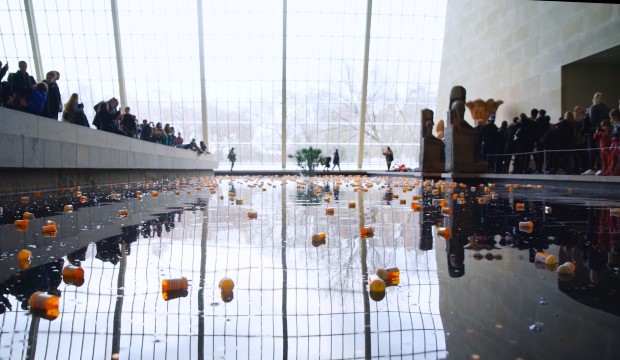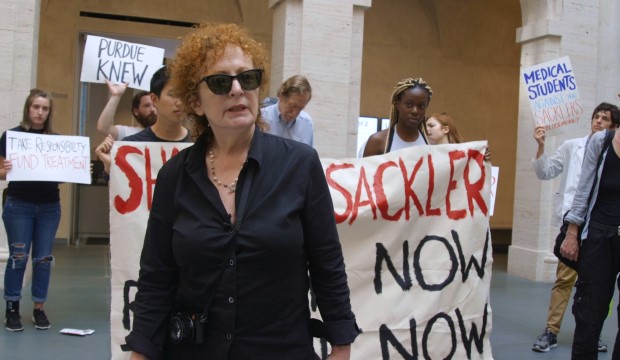All the Beauty and the Bloodshed review ★★★★★
In Laura Poitras' Oscar-nominated documentary, Nan Goldin battles against big pharma and the Sackler family while examining her own upsetting background
Nan Goldin in All the Beauty and the Bloodshed (Photo: Christelle Randall)
All the Beauty and the Bloodshed is Oscar-nominated for Best Documentary and won the Golden Lion at the Venice Film Festival 2022.
Prior to the Hulu/Disney+ drama Dopesick, starring Michael Keaton and Kaitlyn Dever, this critic had little-to-no knowledge of the Sackler family and the American opioid crisis. In the limited series, the big pharma billionaire Richard Sackler is depicted by Michael Stuhlbarg as a supervillain-in-waiting, marketing OxyContin as a safe and non-addictive painkiller. While watching Laura Poitras' documentary All the Beauty and the Bloodshed, those impressions become more tangible.
Poitras centres on the photographer and activist Nan Goldin: drifting between the latter's protests at Sackler-funded museums and her heady background in ‘the banality and deadening grip of suburbia’, prior to entering New York's underground art scene. Aside from Goldin's previous involvement in the Act Up protests, these two narratives struggle to stick together – bifurcating more than intertwining.
But All the Beauty and the Bloodshed is still a fascinating, gruelling, and often entertaining look at the past and present of such a maverick figure in the art world.

Nan Goldin's protest at The Met in New York. Photo: Christelle Randall
Conducted in famous galleries, Goldin’s protests with activist group P.A.I.N. (Prescription Addiction Intervention Now) are like installations in themselves. One involves throwing pill bottles into a moat of water in the Sackler Wing at The Met. They chuck hundreds of prescription slips into the atrium of The Guggenheim, evoking the blizzard of pain and death from which the Sacklers profited. The documentary appears to serve, at least in part, as a way of explaining why the photographer fights so hard for this cause.
Goldin’s had a turbulent life. She talks about her closeted sister, who was institutionalised several times before dying by suicide. You see Goldin’s family and her home, the photos of which, under the poetic spell of her voiceover, almost come alive. The pictures are still, yet they move, like the memories she’s trying to recover.

Nan Goldin. Photo: Christelle Randall
Goldin’s memorable slideshows, including The Ballad of Sexual Dependency, punctuate the film. They’re striking in their down-and-dirty eroticism – pre-coital, post-coital, fully coital – as well as ebullient in their joy, celebrating urban outliers in clubs and bars during the liberated hours of the night. The grind of finding exhibitors is always absorbing, sharply shadowed here by Goldin’s jobs in bartending, stripping, and sex work.
The provocative nature of her photography exacerbated that journey, but friends and creatives and drag queens pulled her through. The appearance of artist David Wojnarowicz becomes a highlight, the film using clips from archive interviews in which he elevates the effect of controversy – claiming it showed that ‘the control of information has a crack in its wall’. Had he not died of AIDS in 1992, you wonder what he would’ve made of this oversaturated digital age.
All the Beauty and the Bloodshed is a story of art, the struggle to make it, and its power to lift the artist out of the wells of their lives. It’s a privilege to stay in Nan Goldin’s company for this length of time. She’s a rebel, a fighter, and speaks truth to power through her creativity and her protests, which are often one and the same.
All the Beauty and the Bloodshed will be in UK cinemas on Friday 27 January.
Prior to the Hulu/Disney+ drama Dopesick, starring Michael Keaton and Kaitlyn Dever, this critic had little-to-no knowledge of the Sackler family and the American opioid crisis. In the limited series, the big pharma billionaire Richard Sackler is depicted by Michael Stuhlbarg as a supervillain-in-waiting, marketing OxyContin as a safe and non-addictive painkiller. While watching Laura Poitras' documentary All the Beauty and the Bloodshed, those impressions become more tangible.
Poitras centres on the photographer and activist Nan Goldin: drifting between the latter's protests at Sackler-funded museums and her heady background in ‘the banality and deadening grip of suburbia’, prior to entering New York's underground art scene. Aside from Goldin's previous involvement in the Act Up protests, these two narratives struggle to stick together – bifurcating more than intertwining.
But All the Beauty and the Bloodshed is still a fascinating, gruelling, and often entertaining look at the past and present of such a maverick figure in the art world.

Nan Goldin's protest at The Met in New York. Photo: Christelle Randall
Conducted in famous galleries, Goldin’s protests with activist group P.A.I.N. (Prescription Addiction Intervention Now) are like installations in themselves. One involves throwing pill bottles into a moat of water in the Sackler Wing at The Met. They chuck hundreds of prescription slips into the atrium of The Guggenheim, evoking the blizzard of pain and death from which the Sacklers profited. The documentary appears to serve, at least in part, as a way of explaining why the photographer fights so hard for this cause.
Goldin’s had a turbulent life. She talks about her closeted sister, who was institutionalised several times before dying by suicide. You see Goldin’s family and her home, the photos of which, under the poetic spell of her voiceover, almost come alive. The pictures are still, yet they move, like the memories she’s trying to recover.

Nan Goldin. Photo: Christelle Randall
Goldin’s memorable slideshows, including The Ballad of Sexual Dependency, punctuate the film. They’re striking in their down-and-dirty eroticism – pre-coital, post-coital, fully coital – as well as ebullient in their joy, celebrating urban outliers in clubs and bars during the liberated hours of the night. The grind of finding exhibitors is always absorbing, sharply shadowed here by Goldin’s jobs in bartending, stripping, and sex work.
The provocative nature of her photography exacerbated that journey, but friends and creatives and drag queens pulled her through. The appearance of artist David Wojnarowicz becomes a highlight, the film using clips from archive interviews in which he elevates the effect of controversy – claiming it showed that ‘the control of information has a crack in its wall’. Had he not died of AIDS in 1992, you wonder what he would’ve made of this oversaturated digital age.
All the Beauty and the Bloodshed is a story of art, the struggle to make it, and its power to lift the artist out of the wells of their lives. It’s a privilege to stay in Nan Goldin’s company for this length of time. She’s a rebel, a fighter, and speaks truth to power through her creativity and her protests, which are often one and the same.
All the Beauty and the Bloodshed will be in UK cinemas on Friday 27 January.
TRY CULTURE WHISPER
Receive free tickets & insider tips to unlock the best of London — direct to your inbox
| What | All the Beauty and the Bloodshed review |
| When |
27 Jan 23 – 27 Jan 24, IN CINEMAS |
| Price | £determined by cinemas |
| Website | Click here for more information |